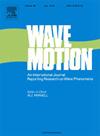Fourth-order Stokes theory for capillary–gravity waves in arbitrary water depth on linear shear currents
IF 2.5
3区 物理与天体物理
Q2 ACOUSTICS
引用次数: 0
Abstract
In this paper the two-dimensional steady surface capillary–gravity waves, incorporating the effects of linear shear currents, is studied in water of constant depth. Herein, linear shear currents are considered to be a linear combination of depth-uniform current and uniform vorticity. Employing an excellent Stokes expansion method, where the expansion parameter represents the wave steepness itself, a fourth-order perturbation series solution for plane progressive waves is developed. The key results of this work are (a) to find the influence of both co-flowing and counter-flowing currents on the wave profiles using the fourth-order approximation (b) the strong dependence of the wave velocity on both the magnitudes of the shear and depth-uniform current, (c) the Wilton singularities in the Stokes expansion in powers of wave amplitude due to a inverse Bond number of , and , which are the results of the non-uniformity in the ordering of the Fourier coefficients are observed to be influenced by vorticity and depth-uniform current, (d) distinct surface profiles of capillary–gravity waves are obtained and the effects of depth-uniform currents on these profiles are described. This analysis also shows that for any given value of the water depth, there exist a threshold value of the vorticity above which no resonances occur. For the steepest waves considered in this analysis, it is observed that when the wavenumber is not in the vicinity of certain critical values, determined by the depth and the vorticity, the present fourth-order analysis shows significant deviations on the surface profiles from the third-order analysis and provides better results consistent with the exact numerical results.
线性切变流下任意水深毛细管重力波的四阶Stokes理论
本文研究了在定深水中考虑线性剪切流影响的二维稳定表面毛细重力波。在这里,线性剪切流被认为是深度均匀电流和均匀涡量的线性组合。采用一种优秀的Stokes展开方法,其中展开参数表示波的陡度本身,给出了平面进行波的四阶摄动级数解。这项工作的关键结果是:(a)使用四阶近似找到了共流和逆流电流对波浪剖面的影响;(b)波速对剪切和深度均匀电流的大小都有很强的依赖性;(c)由于逆键数为1/2,1/3和1/4,所以斯托克斯展开中的威尔顿奇点在波浪振幅的幂次上,(d)得到了毛细管重力波的不同表面剖面,并描述了深度均匀流对这些剖面的影响。分析还表明,对于任何给定的水深值,存在一个涡度阈值,超过该阈值不发生共振。对于本分析中考虑的最陡波浪,当波数不在由深度和涡度决定的某些临界值附近时,四阶分析在表面剖面上与三阶分析有明显的偏差,并提供了与精确数值结果更一致的结果。
本文章由计算机程序翻译,如有差异,请以英文原文为准。
求助全文
约1分钟内获得全文
求助全文
来源期刊

Wave Motion
物理-力学
CiteScore
4.10
自引率
8.30%
发文量
118
审稿时长
3 months
期刊介绍:
Wave Motion is devoted to the cross fertilization of ideas, and to stimulating interaction between workers in various research areas in which wave propagation phenomena play a dominant role. The description and analysis of wave propagation phenomena provides a unifying thread connecting diverse areas of engineering and the physical sciences such as acoustics, optics, geophysics, seismology, electromagnetic theory, solid and fluid mechanics.
The journal publishes papers on analytical, numerical and experimental methods. Papers that address fundamentally new topics in wave phenomena or develop wave propagation methods for solving direct and inverse problems are of interest to the journal.
 求助内容:
求助内容: 应助结果提醒方式:
应助结果提醒方式:


